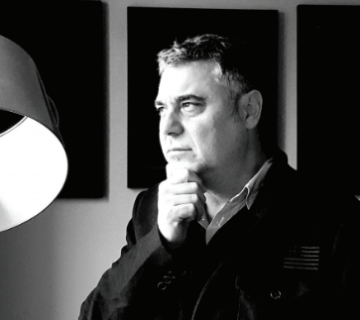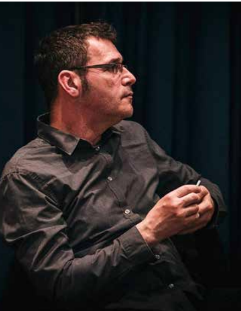A writer, publicist and linguist now based in New York, Ardian Vehbiu is the author of 15 books, including several works of fiction, as well as works of non-fiction focusing on the linguistic and semiotic aspects of contemporary Albanian culture. He has notably analyzed public discourse in totalitarian Albania and the nature of exchanges between cultures lacking common codes of communication. He is the founder, director and editor of “Peizazhe të fjalës” (Landscapes of the Word), an Albanian-language online cultural magazine.
“Gjeneral Gramafoni” (General Gramophone) is a 1978 Albanian film directed by Viktor Gjika and produced by the then state-owned Kinostudio “Shqipëria e Re” (New Albania). An Italian entrepreneur-cum-spy comes to pre-war Albania, seemingly to produce commercial records of Albanian traditional folk tunes. The saze musicians hired for the gig seem enthusiastic at first, but then conflict ensues, just as Albania’s occupation by Mussolini’s armies looms in the horizon.
Traditional Albanian culture is depicted, in the film, through people’s conviviality: folk musicians are part of everyday life and help it come alive. They are invited to perform at weddings, anniversaries and other traditional events; their art is oral and shared. The very nature of the music performed by the Albanian saze groups is supposed to integrate and resonate with the feelings of the collectivity and people’s reaction to pain, injustice and loss – one can’t help thinking of the Mississippi blues and the powerful effects of live, spontaneous musical performances around the world.
However, their Italian employer now wants them to play in a studio and in front of microphones, for a far-away public they can hardly imagine and interact with. The folk group’s instrumental play is always based on improvisation and is context specific; which clashes with the written and permanent nature of the gramophone record. If everything goes as planned with the production, Albanian music will be played and listened to in distant places, where the musicians themselves won’t be needed. The recording process intends to separate the performing of music from the musical end product – which the musicians experience as a trauma, even as they struggle to understand it fully.
The newly produced records will contain, however, uprooted music; which retains a certain beauty, but is now free to be used mostly for entertainment. People in Italy will buy them in stores and will listen to them for fun, often forgetting where these taxidermized products come from and what function they used to serve; the gramophone will offer this music a new miniature, mechanical stage.
But when the musicians listen to their sounds and voices, as recorded in the studio, they feel betrayed: this is no longer their music – the recording process has killed its very soul. Their anxiety is fueled by the inability of a largely oral society and culture, like the one in 1930’s Albania, of negotiating within a new system that has left orality behind, having replaced it with literacy and the writing technology, in general.
The musical conflict that takes place in the recording studio isn’t but a scale reproduction of the massive modernization impact that the West, Italy in particular, was making on Albania at the time – with technology such as the drilling for oil, the first automobiles roaming through the narrow city streets and the motorcycles of the private police hired by the oil drillers.
Director Viktor Gjika had the brilliant intuition to represent, this conflict, as a clash between wood and metal: wood is in the houses, everyday utensils, furniture, handcrafted merchandise, the saddles of horses and mules and especially the musical instruments that “speak” music; metal is present in the cars and the trucks and the oil drills and the weapons and the recording equipment, including a sophisticated photo camera Mr. Alberto, the producer, take pictures with, in his second job, as a spy preparing the Italian invasion.
With technology comes privileged, if not proprietary, access and social division along vertical lines; but this privilege is promptly concealed behind the apparent massive availability of consumer products, such as records; and the availability of tools, such as gramophones, to play any record, just like mercenaries ready to fight in any war. Orality, on the other hand, offers open access to everyone; it does not need to “record” anything, because it is based on memory, improvisation, and circularity.
There comes a moment in the film, during one of the studio recording sessions, when one of the technicians attempts to demonstrate, to the Albanian folk musicians, the kind of music they are expected to play. In what sounds like a caricature of jazz manouche, he first demonstrates “the pump”, then plays a chromatic scale on the violin. A capital offense for the musicians! For these artists, steeped in orality, the whole recording process in view of massive (industrial) reproduction doesn’t mean much. They do not recognize themselves in the music that is played back to them; and the attempt to bring together western technology and the Albanian folk music falls short.
At the time the film was made, the Albanian totalitarian regime had chosen isolation and embraced paranoid nationalism in order to extend its life. By extension, director Viktor Gjika and screen writer Vath Koreshi reposition the technological conflict as a confrontation that jeopardized the very “survival” of the Albanian culture and nation. While orality was alive in 20th century Albania mostly due to poverty, and illiteracy, the film authors imbued it with exaggerated nationalist virtues.
When the film was being shown in theaters in Albania and promoted as a masterpiece of the New Albanian Cinema, mass-produced folk art was widely propagandized and disseminated as part of the totalitarian indoctrination against contact with the outer world. However, the folklore artificially popularized by the government had little in common with genuine folk culture. Its artistic merit notwithstanding, “General Gramophone” did actually participate in this staged orality.
The film strived to prove, among other things, that folk music helped protect “the people” against cultural aggression from abroad; only because it was a product of the people. The clash between wood and metal, human and inhuman, was recast as a metaphor for the confrontation between “us” and “them”, echoing the official paranoid line of the regime.
Only three years later the film’s deep theme, about the conflict between orality and technology, wood and metal, would reappear, in a 1981 novel by Ismail Kadare: “Dosja H” (translated and published in English as “The File on H.”). Willy and Max, two Homeric scholars from Ireland, by way of Harvard University, venture into North Albania’s deep hinterland in the late 1930s, to study the diffusion and reproduction of oral epic poetry as sung by itinerant minstrels accompanied by the single-stringed lahuta (also known as gusle). They have also brought along with them a bulky magnetic tape recorder, to make multiple recordings of the same song and then find out common patterns.
The novel’s plot is based on real research expeditions undertaken by Milman Parry and Albert Lord, who studied the epic poetry performance in Bosnia, Serbia, and Croatia and partly among Albanians as well, to come up with a new revolutionary model about how oral culture works.
These two foreign travelers on mission echo another significant duo in Kadare’s work: the general and the priest, who visit Albania in “The General of the Dead Army” to look and dig for the remains of dead WW2 soldiers. They seem equally keen on collecting pieces of Albania’s past and end up equally transformed by the experience. However, unlike the two Italian officials in the earlier novel, the two researchers aren’t interested as much in what is dead and buried, as in what is still alive in Albania’s epic poetry.
The North Albanian Epos has been extensively researched; local Catholic priests wrote down the songs and published them early in the 20th century. But the two Irish scholars in the novel take it a step further and throw the tape recorder into the mix, in order to “photograph” the singing process and thus capture the action alive.
There is nothing innocent about the tape recorder, as it introduces the element of the magnetic writing in the oral universe of the epos; or the very technology that is going to eventually destroy traditional song performing practices. This metallic creature poses a deadly challenge to the minstrel’s wooden weapon: the lahuta (also known elsewhere as gusle).
The scholarly expedition takes place in a world haunted by paranoia – both government fueled and traditional. The two scholars are constantly and secretly shadowed by a local police agent who eavesdrops on them, to figure out what exactly they are doing. While Willy and Max penetrate the heart of this deeply oral culture, the eavesdropper compiles extremely detailed reports, in writing, of their enigmatic activities. As Willy and Max make magnetic recordings, their diligent shadow transcribes everything that comes to pass. Both parties represent types of media technology only recently introduced into the remote Albanian Alps – both parties symbolize attempts, by the “civilized” world, to deal with the oral challenge, and tame it. Yet, while the eavesdropper does not dare disturb the scholars’ work, the scholars cannot help interfering with the minstrels’ live performances.
Just as the gramophone and the records would announce a challenge to oral music practices in “General Gramophone”, the tape recorder in “The File on H.” also becomes the harbinger of death for the minstrels and their role in the survival of the epos. Will these epic songs outlive the disappearance of the performative dimension?
“The minstrel is part of the epos machine. He is its editor, its distributor, its archivist and, at the same time, he is a lot more – a co-author with the right to change the text,” says one of the characters in the novel.
What the technologies of mechanical recording and reproduction do to orality is weaken people’s capacity to remember and forget, by sourcing it outside of the human body. They also transfix the songs in time and space and render them immutable.
Unlike the gramophone in the “General Gramophone” film, which “reads” the musical records aloud, the magnetic tape recorder operated by the two Irish researchers is a tool for capturing and archiving the sound. By doing so, it alienates oral culture by disembodying or “stealing” the minstrel’s voice.
A passage from the novel illustrates this [English translation is mine, A.V., from the original in Albanian]:
“When the minstrel’s voice boomed from the machine, a bit louder than before, everybody froze. The minstrel was still there, his mouth shut and the silent lahuta in his hand, but the voice and the instrument could still be heard. The detachment of a human part and its taking up a life of its own was beyond shocking.”
Once again, the recording process brings orality and the mechanical reproduction to a confrontation – which serves as a metaphor for Albania’s cultural history during the 20thcentury. As it might well go without saying, the fate of orality is sealed.
As Albania becomes known to scholars from the West, it loses its “oral soul”, just as a lab animal gives up its ghost on the dissection table. The existential drama gets somehow recorded by the moribund epos itself, at least in the narrative world of the novel: “a contraption has arisen from the sea…”. The victim immortalizes the executioner.
Traces of the now-extinct, oral Albania have mostly survived in today’s spoken language – proverbs, idiomatisms, sayings, riddles. The rest reaches us indirectly, “mediated” by the technology – written, recorded, produced, multiplied and distributed. What currently passes for folklore is simply the studied, commercial staging of detailed scripts.
It might be all but impossible to understand what the Albanian culture has lost, by abandoning its oral dimension; but at least we can be aware of the extension of the trauma. The gramophone and the tape recorder depicted in the works mentioned above as the tools that helped kill orality, now can help us remember it and try to understand it.







